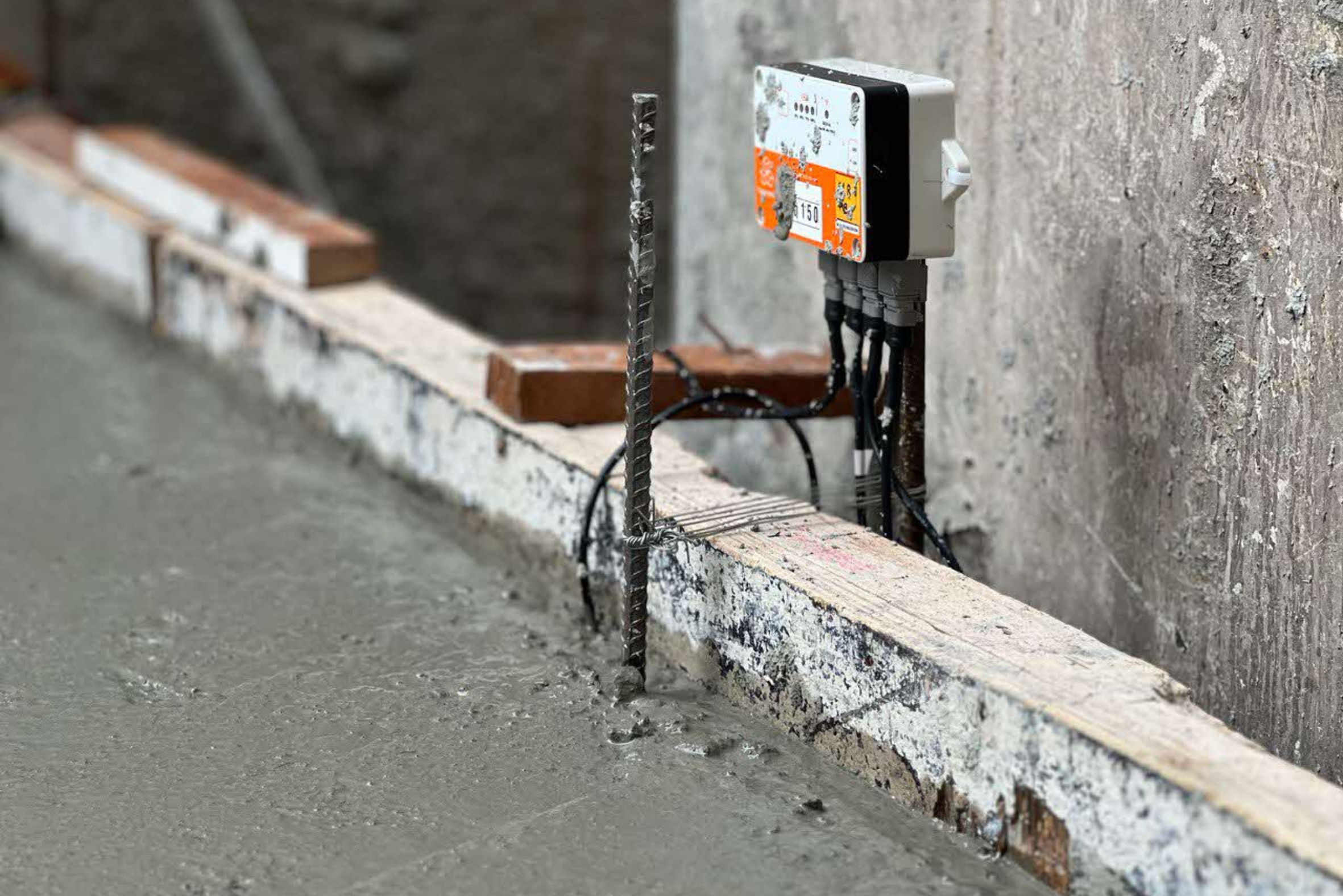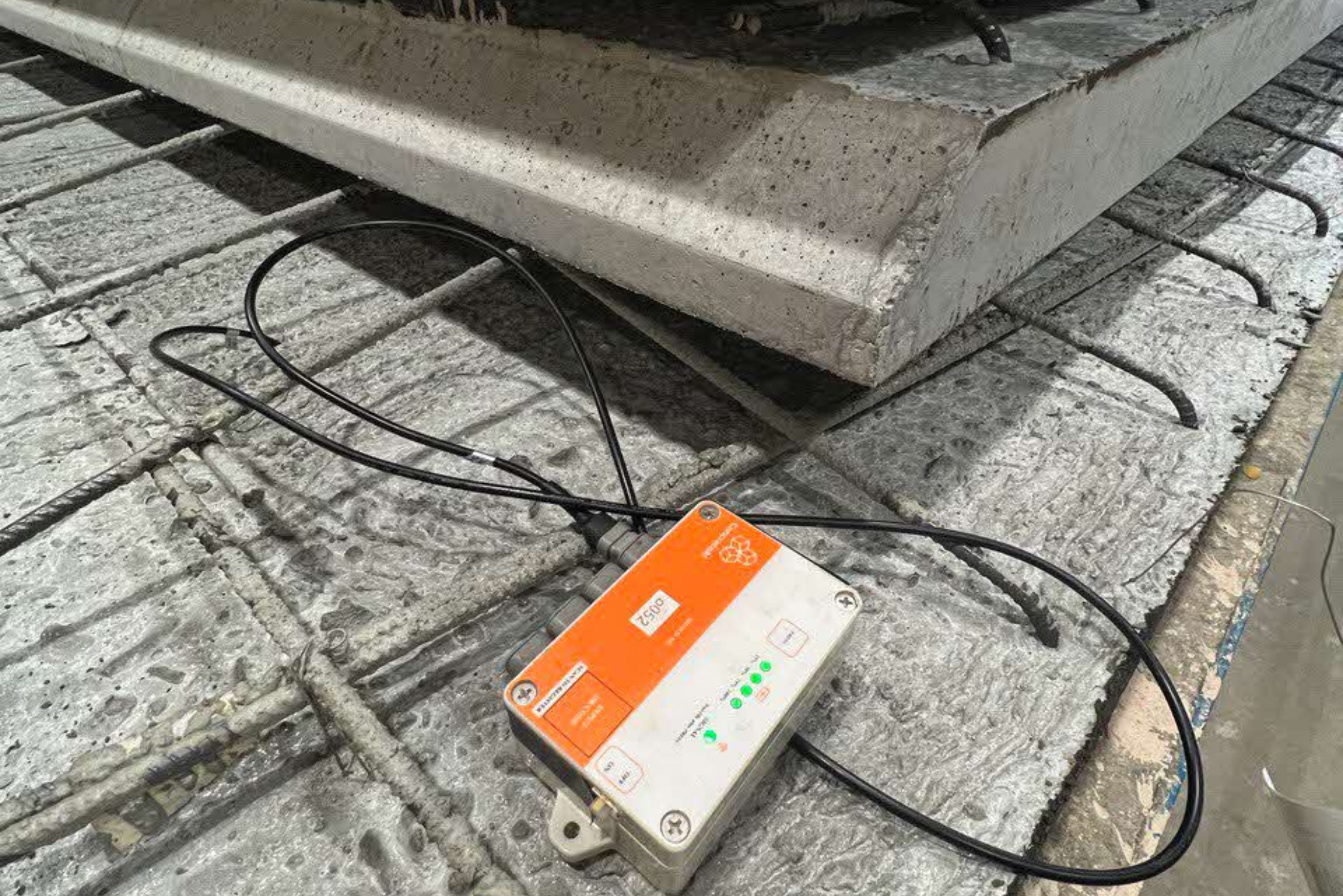Concrete is the backbone of the construction industry. However, a key blind spot saps time, energy, and resources: not knowing when the strength of concrete has reached sufficient thresholds to hold up a load-bearing structure. Enter SmartHub, a potential game-changer for an industry constantly on the lookout for greater productivity.
Developed by local start-up ConcreteAI in 2021, their concrete-monitoring system uses sensors to track temperature and humidity data of freshly poured concrete real-time and provide a live visualisation of the hardening process.
Curing: a process where cement chemically reacts with water and other ingredients to form the solid, stone-like material (i.e. concrete), makes up the core of our buildings. Traditionally, engineers rely on cube testing, taking small samples of concrete to crush in a lab at fixed intervals to test for compressive strength. However, due to temperature variations, these samples often do not accurately reflect the actual strength of on-site concrete, while the lab-testing process remains costly in time and dollars.
“The strength in the actual structure accelerates a lot faster than the current standard-cured cubes in early ages, primarily due to the higher temperatures experienced by in-situ concrete during the hydration process, which accelerates strength development,” explained Ms Qingyang Chang, Co-founder and Chief Executive Officer of ConcreteAI, pointing to Singapore’s warm climate which accelerates the curing process. “That gap causes productivity loss and leads to the overuse of high-performing materials, which wastes both resources and money.”
SmartHub, the solution offered by ConcreteAI, is a quicker, non-destructive and more reliable alternative that monitors the strength of on-site concrete in real time. Once the concrete reaches the temperature that correlates with the strength required for the next stage of construction, SmartHub automatically sends out an alert. By rethinking a traditional process, Ms Chang and her team are transforming the industry from its foundations - metaphorically and literally.
 Smarthub measuring compressive strength of on-site in-situ concrete in real-time
Smarthub measuring compressive strength of on-site in-situ concrete in real-time
From school project to concrete success
SmartHub has its roots from a final-year project that Ms Chang had worked on in 2021, as a Civil Engineering undergraduate at the National University of Singapore (NUS). Inspired by an overseas hackathon, where she and her NUS groupmates explored challenges in construction, Ms Chang recalls: “Tracking concrete strength was one of the key challenges that was proposed. It’s very critical for a project’s productivity, but the current way of doing it is very manual and wasteful.”
As the act of pouring concrete is the first step in casting, the curing phase determines how soon work can continue. By tracking strength in real time, SmartHub informs teams exactly when it is safe to proceed to the next step (e.g. formwork removal). This shortens casting cycles by at least 30 per cent. With faster project completion, it delivers at least a fivefold return on investment through manpower and time savings. This, in turn, helps support the economy, with construction contracts expected to reach up to $53 billion this year.
To stay on schedule, contractors often switch to higher-grade concrete mixes with faster curing or greater strength. However, these mixes typically contain more cement, which drives up costs and increases carbon emissions. SmartHub enhances quality, productivity, and sustainability by demonstrating that low-carbon concrete blends perform comparably in success to traditional mixes: these blends are not only more durable but have a much smaller carbon footprint.
The use of SmartHub removes the need for less ideal concrete mixes, equipping contractors with confidence to decisively choose low-carbon concrete blends without jeopardising progress.
Thus far, SmartHub has been deployed in 10 projects since 2021 with encouraging results. In one instance, it saved 7 manhours per segment of a road viaduct project of the Land Transport Authority's NSC by measuring in-situ concrete strength. However, in spite of proven results, its wide adoption in the industry has been slower than expected, due to resistance to change and reliance on the norm of cubetesting.
In response, ConcreteAI launched SmartCure in 2023 as a complementary product to the current cube-testing method. SmartCure is a portable tank that stores cube samples in water, where the water temperature is automatically adjusted to match the real-time temperature of the concrete cast on-site. This approach, known as Temperature-Matched Curing (TMC), cuts the cube-testing process from the standard seven days to just three. Provisions for TMC are available in BS 1881-130 Testing concrete – a method for temperature-matched curing of concrete specimens.
“The idea was to use destructive testing to gain insights into in-situ concrete strength and verify the real-time strength provided by Smarthub, increasing flexibility for teams to adopt the solution” said Ms Chang, calling SmartCure a “middle-ground” solution that has been well-received and paves the way towards greater adoption of SmartHub.
Teaming up for impact
As a start-up, ConcreteAI gained traction through the Built Environment Accelerate to Market Programme (BEAMP), facilitating collaboration with established industry players, such as Precast Concrete, a producer of precast concrete components and a subsidiary of Soilbuild Construction. This provided ConcreteAI with a real-world testbed for both SmartHub and SmartCure in precast production, allowing ConcreteAI to experiment with and establish a wider variety of real-world use cases.
 ConcreteAI test bedding SmartHub and SmartCure in precast production
ConcreteAI test bedding SmartHub and SmartCure in precast production
“It’s not (just) about how good your technology is, but where you use it,” Ms Chang explained, adding: “BEAMP gives us a very good chance to engage with the built environment stakeholders. They sit down with you to go through their day-to-day work, so you understand exactly what they’re facing.” This feedback enables ConcreteAI to tailor solutions to meet industry specific needs.
“Once a specification is out, everyone can follow that. It will be a matter of how and where it will be adopted," said Ms Chang, in the journey of SmartHub referring to it becoming a code of practice. Currently being trialled with LTA, SmartHub is a success story that establishes local practice for real-time monitoring solutions of concrete curing in Singapore’s built environment, increasing productivity across construction sites nationwide one concrete cure at a time.